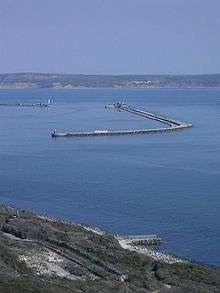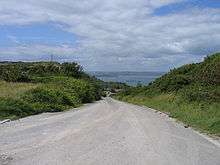HMS Osprey, Portland

HMS Osprey was an anti-submarine training establishment established at the Isle of Portland, Dorset, England, between 1924 and 1941, when its functions were transferred to Dunoon. HMS Osprey was at Dunoon until 1946, the name also being allocated to a smaller base established at Belfast in 1943. Osprey recommissioned at Portland in 1946, became a base in 1948 and was closed in 1995. The helicopter station RNAS Portland, which shared the same name from 1959, closed in 1999.
The establishment worked alongside the Admiralty Underwater Weapons Establishment based at Barrow Hill in Portland's southern-most village Southwell. Both establishments remains infamous for espionage infiltration. Over the decades scientists at Portland became world pioneers in underwater warfare and detection. Portland's research focused on underwater weapons, from ASDIC and sonar in the 1920s to acoustic homing Stingray torpedoes in the 1980s.[1]
History

Creation of shore-based establishment and World War II (1924–1945)
HMS Osprey was originally the command ship of the First Anti-Submarine Flotilla, commissioned in Portland Harbour to run the Royal Navy Anti-Submarine School on 1 April 1924.[2] The name Osprey was taken from an Admiralty Whaler of the Z class.[3] Portland Harbour had become an important site for research into underwater defence equipment when Robert Whitehead established his Torpedo factory at Ferrybridge in 1891, to manufacture and test torpedoes.[4]
The First World War saw the initial development of such anti-submarine measures as depth charges, howitzers and hydrophones. With the increasing need for anti-submarine research, the HMS Osprey establishment was moved onto land in 1927 as a shore-based establishment, keeping its original ship name. The establishment was largely involved in ASDIC and sonar development.[2][3] In November 1936 King Edward VIII made an official visit to the island in order to view the establishment, following a major rebuilding project that was completed that year.[5] With the outbreak of World War II, Portland was a natural target for German aircraft, due to the importance of island's naval base.[6] As a result, the establishment was transferred to Dunoon in Scotland, and Portland's shore-base became commissioned as HMS Attack.[7]
Role in Cold War (1946–1959)
The establishment remained in Dunoon until 1946, and Portland's Osprey establishment was revived after the war to assess the potential of anti-submarine helicopters.[2] The beginning of the Cold War period saw the Admiralty choosing Barrow Hill, near Southwell village, to build a new Admiralty Gunnery Establishment. The work at the Southwell site commenced in 1949 and was completed during 1952.[8] In 1959 the AGE site became part of the Admiralty Underwater Weapons Establishment (AUWE). Throughout its working life, the Southwell establishment worked alongside the East Weares establishment, where the two Portland establishments, known as AUWE(S) and AUWE(N) respectively, were responsible for the design, development and testing of underwater weapon and detection systems.[9] This amalgamation mean that all the research into underwater weapons was moved to Portland, including work with the highest security classification at the height of the Cold War.[10]
The assessment of anti-submarine helicopters led to the creation of the Royal Naval Air Station in 1959, which perpetuated the name HMS Osprey.[2] In 1946 Sikorsky R-4Bs had moved in, initially operating from the slipway at the Naval Base for development work. The helicopters paved the way for the use of helicopters in the fleet, and success with these trials, and with aviation activities on the increase, the Admiralty decided to replace fixed-wing anti submarine aircraft with helicopters, heralding a major building programme at Portland. The continuing success of the helicopter operations inevitably led to the need for better and purpose built facilities over the years. During the late 1950s the marshy area known as the Mere was filled in and built over. For the next 40 years RNAS Portland was one of the busiest air stations on the south coast, with helicopter operations taking place 24 hours a day. As a helicopter development and training base, it was largely responsible for training aircrew in anti-submarine operations.[11] To distinguish between the two sites, the research establishment was often referred to as the upper part of HMS Osprey.
Portland Spy Ring case (1961)
In 1961 Portland's two establishments at Southwell and East Weares were the centre of worldwide attention, after the discovery of espionage infiltration. This became infamously known as the Portland Spy Ring, a Soviet spy ring that operated in England from the late 1950s till 1961 when the core of the network were arrested by the British security services. It is one of the most famous examples of the use of illegal residents — spies who operate in a foreign country but without the cover of their embassy.
Of the five arrests made in January 1961, two of the ring were local residents of Weymouth and Portland - Henry Frederick Houghton and Ethel Elizabeth Gee. The pair had met and formed a relationship through their work within Portland's establishments, as civil servants.[12] As the pair had access to secret material, an agreement was made to hand information over to Soviet intelligence officer Gordon Lonsdale, in exchange for money. The pair made regular trips to London in order to hand over information to Lonsdale, who in turn would send the information to the USSR via a bungalow in Ruislip. The residence belonged to Peter and Helen Kroger, who themselves were on the FBI's wanted list regarding connection to a similar espionage case.[13]
A trial at the Old Bailey in March 1961 saw Gee affirm her innocence, where she openly admitted that naivety caused her to play her role, with Houghton being a long-awaited love to "sweep her off her feet". Houghton would later state that Gee did not have a full grasp of the understanding relating to the tasks he had asked her to carry out.[12] Houghton's reasoning at the trial was that he had been blackmailed by the Poles and the Russians into spying for them, and that the information he gave them were already in the public domain.[14]
At the end of the trial Lonsdale was given a sentence of 25 years, the Krogers given 20 years, while Houghton and Gee were both sentenced to 15 years imprisonment. Lonsdale did not serve much of this sentence, as in April 1964, he arrived in Berlin to be exchanged for the British spy Greville Wynne. In 1969 the Krogers were also exchanged - for the lecturer Gerald Brooke. Houghton and Gee served 10 years of their sentences, and were released in 1971, where they soon married and changed their names. Houghton later wrote an autobiography, titled Operation Portland, which was published in 1972.[12]
Continued operations and eventual closure (1960s–1995)
RDV 01 Crystal, an unpowered floating research vessel was situated in Portland Harbour for a number of years. It was designed to be used during sonar research and development projects at the Admiralty Underwater Weapons Establishment (AUWE) at Portland Harbour. It was not fitted with any propulsion or steering gear. The vessel was ordered from the builders HM Dockyard, Devonport, in December 1969, and launched in March 1971. It was sold on 18 September 1992 to a Dutch concern.[15]
During the 1980s, work began on the construction of accommodation buildings and a sports centre at Castletown, totaling £25-30 million. However, during the early 1990s it was announced that the base would close, following the ending of the Cold War. In 1995 the Royal Navy closed their Portland base, and the most obvious evidence of their departure was the absence of warships. However what was less obvious, but just as devastating to Portland, was the huge range of buildings of the research establishments. The buildings were left empty, with an uncertain future.[16] Once the closure of the naval base and establishments had been completed, RNAS Portland's closure followed on 31 March 1999. The research carried out at Portland, now under the Defence Evaluation and Research Agency (DERA) since 1995, was relocated to the Atomic Energy Agency's business park at Winfrith, leaving Bincleaves as the sole establishment in the Portland Harbour area.[17]
Aftermath (1990s-)
During the late 1990s, it was decided to convert the HMS Opsrey complex at East Weares into a holiday village.[18] These plans were set, but did not come to fruition. The buildings at Southwell stood empty too, and the Ministry of Defence made plans to demolish them, and then seek permission for either building or mineral extraction. However Roy Haywood and Ray Bulpit, whose business was the acquisition and development of former military sites, then purchased the site. This became the successful Southwell Business Park in 1997.
The East Weares complex continued to remain derelict, and a target for vandalism - to the point where every single window had been smashed. In April 2005 Portland Port Ltd, now the owners and operators of the harbour, demolished the entire complex. Soon after the AUWE Sonar Department research laboratories and offices closer to the dockyard site were also removed. Additionally a large number of historical World War 2 buildings were reduced to rubble to make way for a gas storage scheme, which never came to fruition. These were situated close to the East Weares Rifle Range.[19] At King's Pier, on the eastern coastline close to main HMS Osprey complex, is a remaining waste pipe emerging from the old complex.[20]
References
- ↑ Morris, Stuart (1998). Discover Dorset: Portland. Dovecote Press. p. 60. ISBN 978-1874336495.
- 1 2 3 4 Legg, Rodney (1999). Portland Encyclopaedia. Dorset Publishing Company. p. 82. ISBN 978-0948699566.
- 1 2 "Why Portland's naval base was called HMS Osprey (From Dorset Echo)". Dorsetecho.co.uk. Retrieved 2015-06-23.
- ↑ "The Jurassic Coast - Underwater Research". jurassicagent.co.uk. Retrieved 2014-07-17.
- ↑ Morris, Stuart (1985). Portland: An Illustrated History. Dovecote Press. p. 141. ISBN 978-0946159345.
- ↑ "World War 2". Geoffkirby.co.uk. Retrieved 2015-06-23.
- ↑ Scribbles. "Royal Navy Pay and Conditions". Freepages.genealogy.rootsweb.ancestry.com. Retrieved 2015-06-23.
- ↑ Legg, Rodney (1999). Portland Encyclopaedia. Dorset Publishing Company. p. 5. ISBN 978-0948699566.
- ↑ "Admiralty and Ministry of Defence: Underwater Weapons Establishment, later Admiralty Underwater Weapons Establishment: Reports and Technical Notes | The National Archives". Discovery.nationalarchives.gov.uk. Retrieved 2015-06-23.
- ↑ "A Portland Success Story | Dorset Life - The Dorset Magazine". Dorset Life. Retrieved 2014-07-17.
- ↑ "The Jurassic Coast - HMS Osprey". Jurassicagent.co.uk. Retrieved 2015-06-23.
- 1 2 3 "The Spy Next Door - People - Dorset". Dorsetmagazine.co.uk. Retrieved 2015-06-23.
- ↑ "MI5 man broke island spy ring (From Bournemouth Echo)". Bournemouthecho.co.uk. Retrieved 2015-06-23.
- ↑ Polmar, Norman; Allen, Thomas B. (1997). Spy Book - The Encyclopedia of Espionage. Greenhill Books. ISBN 1-85367-278-5.
- ↑ "RDV 01 Crystal". World Naval Ships Directory. 2012. Retrieved 29 June 2012.
- ↑ "A Portland Success Story | Dorset Life - The Dorset Magazine". Dorset Life. Retrieved 2015-06-23.
- ↑ http://www.jurassicagent.co.uk/index.php/library/history/deadly-weapons/55-underwater-research
- ↑ Morris, Stuart (1998). Discover Dorset: Portland. Dovecote Press. p. 63. ISBN 978-1874336495.
- ↑ "YOI and Caves on Portland, Dorset". Geoffkirby.co.uk. Retrieved 2015-06-23.
- ↑ "700730". Geoffkirby.co.uk. Retrieved 2015-06-23.
Coordinates: 50°32′37″N 2°27′14″W / 50.54356°N 2.45381°W